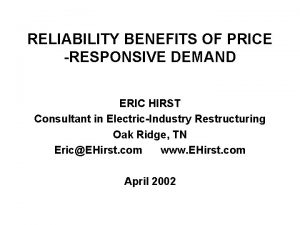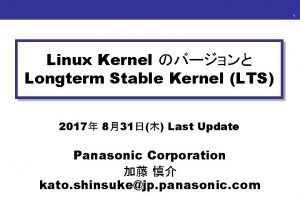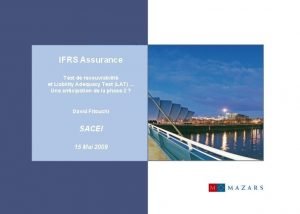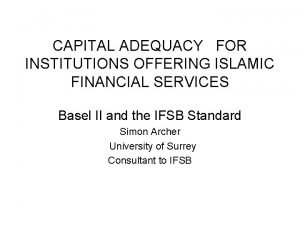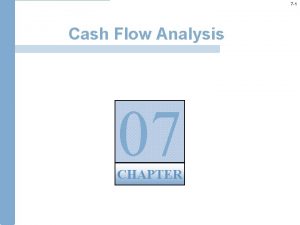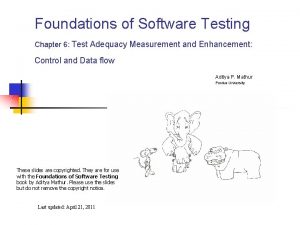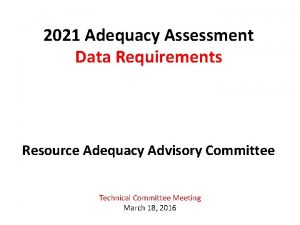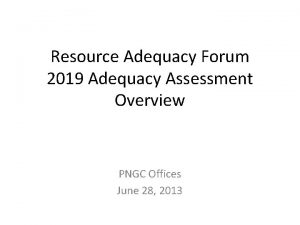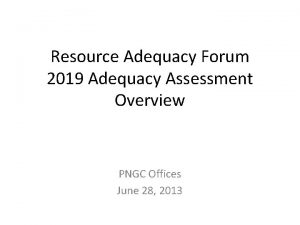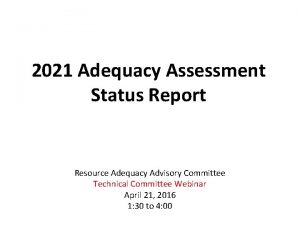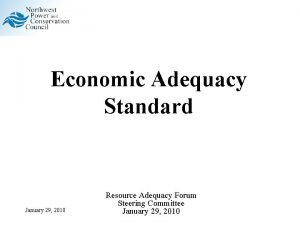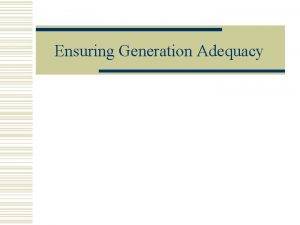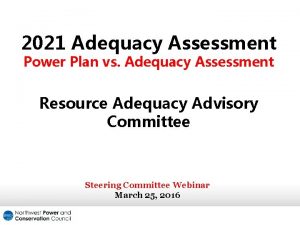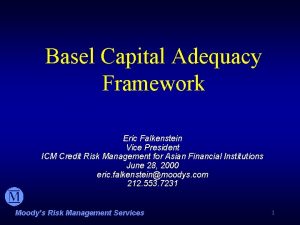LONGTERM RESOURCE ADEQUACY DEMANDRESPONSE OPTIONS ERIC HIRST Consultant



















- Slides: 19

LONG-TERM RESOURCE ADEQUACY: DEMAND-RESPONSE OPTIONS ERIC HIRST Consultant in Electric-Industry Restructuring Oak Ridge, TN Eric@EHirst. com www. EHirst. com November 2002

THREE PROBLEMS WITH THIS ASSIGNMENT n Concept of long-term resource requirement is antithetical to competitive markets – What other products are purchased so far ahead of use with such ambiguous product definition? – For what other products does government mandate purchase? n FERC’s proposed long-term resource adequacy (LTRA) requirements, in SMD NOPR, vague and at odds with other parts of SMD n FERC’s opposition to ISO ICAP programs unclear 2

ASSIGNMENT IS SIMPLE IN ONE SENSE n Demand-response resources/programs developed for shorter term should qualify as long-term resources – No need to develop new programs to ensure LTRA n Challenge is to treat demand resources comparably (not necessarily identically) to supply resources – ISO operating and market rules accommodate supply idiosyncrasies, need to do same for demand resources 3

KEY RESOURCE COULD BE DEMAND CURVE FOR CONTINGENCY RESERVES 4

ISSUES TO CONSIDER. . . n Forecast horizon n Certification requirements n Qualifying resources – Interruptible loads and direct-load control – Dynamic pricing – Load participation in contingency-reserve markets – Energy efficiency n Seasonal v annual requirements n RTO role in markets n End-use infrastructure requirements – Metering and communications 5

… ISSUES TO CONSIDER n n n RTO resource rights Retail customer/LSE obligations Minimum resource size Customer baseline level Payments – Capacity – Energy n Penalties n Other ? ? 6

UNCERTAINTY OVER RESOURCES INCREASES WITH FORECAST TIME Plans ? ? Physical resources 7

WHAT CONSTITUTES CERTIFICATION AND WHEN? n Resource Plan (long-term) – How does RTO review and approve plan? – Return to the days of utility IRP? n Physical Resource (short-term, e. g. , month ahead) – Demonstration of actual load reduction within time limit (ramp rate), metering and communications equipment – Annual or seasonal demonstration or delivery when called upon 8

WHICH DEMAND RESOURCES CAN QUALIFY? YES – Interruptible loads and direct-load control (participants in existing DR and ICAP programs) – Bids into contingencyreserve markets NO – Dynamic pricing ? Probably not – Energy efficiency, passive nature prohibits system operator dispatch of resource These “resources” show up in load forecast 9

DEMAND RESPONSE MORE VALUABLE AS LOAD REDUCTION n Consider LSE with 100 MW peak demand, 15% reserve requirement, and 10 MW of contracted load reduction n If the 10 MW qualify as LTRs, then LSE needs another 105 MW of qualifying resources n If the 10 MW reduce peak demand, then LSE needs only 103. 5 MW of qualifying resources 10

HOW TO TREAT SEASONAL LOADS? n Some load reductions are weather or season dependent n Some are coincident with system peaks n How to value such time-dependent load reductions? – Calculate annual value based on hourly values of system LOLP and potential load reduction, similar to traditional utility system planning 11

METERING AND COMMUNICATIONS DEPENDS ON TYPE OF RESOURCE Interruptible Load n Meters: hourly Contingency Reserves n Meters: 1 -minute recording n Communications: Receive, confirm, and act upon RTO instructions (pager, telephone, email, fax) n Communications: Receive and act upon RTO dispatch instructions n Does RTO need to know load response in real time? Who pays for this equipment? 12

RTO RIGHTS n Number of times per year (or season) n Maximum duration of each interruption n Minimum advance notice – These limits generally do not apply to generators and reduce the value of demand resources n Point in emergency sequence (OP-4) that resource is called 13

LSE/CUSTOMER OBLIGATIONS n Prompt reporting of availability status n Maintenance of metering and communications equipment n For participation in contingency-reserve markets, submission of daily availability bids ($/MW-hr) 14

PAYMENTS AND PENALTIES n LTRs (both supply and demand) receive monthly or annual reservation/capacity payments, $/MW-month n When dispatched, supply paid for energy at spot energy price and load does not pay for unconsumed energy at same price (Ruff argument, no double payment) n Noncompliance vs. underperformance penalties – Stiff noncompliance penalty is quid pro quo for capacity payments – Underperformance penalty should be cost based 15

MANY OF THESE FACTORS APPLY TO OTHER DEMAND-RESPONSE PROGRAMS n n Minimum resource size Aggregation Frequency, duration, advance notice of deployment Customer baseline level – Easier to determine for contingency reserves 16

COMPARISON AMONG DR TYPES. . . 17

… COMPARISON AMONG DR TYPES 18

MY BOTTOM LINE n LTRA is a political necessity because of aversion to price spikes and deficiencies in current market designs n LTRA not compatible with competitive wholesale energy markets n Demand resources can and should qualify as LTRs and participate in such markets – Build on experience with existing ISO and utility programs – Ensure comparability with treatment of generation 19
 Eric hirst
Eric hirst Linux kernel lts
Linux kernel lts Thomas silverstein
Thomas silverstein A.s environs ltd is dealing in environment
A.s environs ltd is dealing in environment Barry hirst
Barry hirst Corak ideologi menurut hirst
Corak ideologi menurut hirst Enclosing hood
Enclosing hood Desenho de linguagem visual
Desenho de linguagem visual Away from the flock damien hirst
Away from the flock damien hirst Spectragram
Spectragram Away from the flock damien hirst
Away from the flock damien hirst Liability adequacy test
Liability adequacy test Capital adequacy ratio formula
Capital adequacy ratio formula Horizontal and vertical adequacy
Horizontal and vertical adequacy Adequacy
Adequacy What is adequacy in testing
What is adequacy in testing Certificate of adequacy
Certificate of adequacy Cash flow adequacy ratio
Cash flow adequacy ratio Adequacy of test items in testing
Adequacy of test items in testing What is a priori knowledge
What is a priori knowledge
